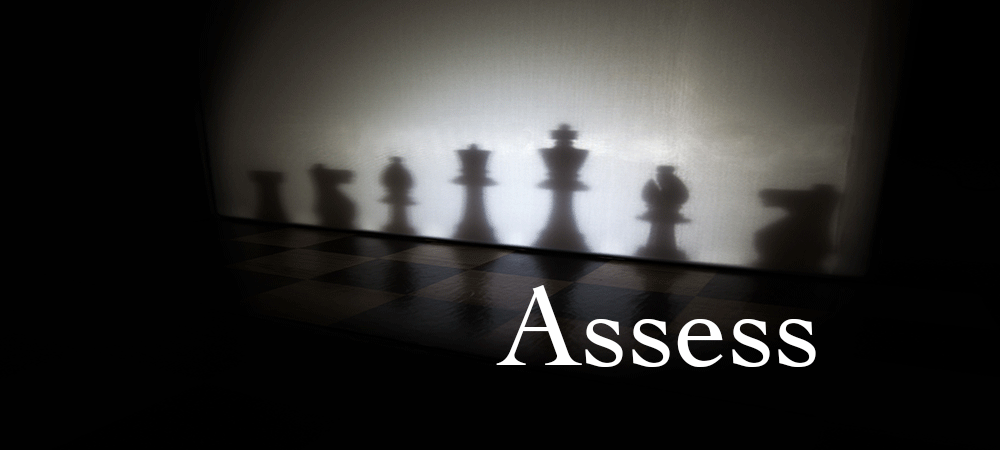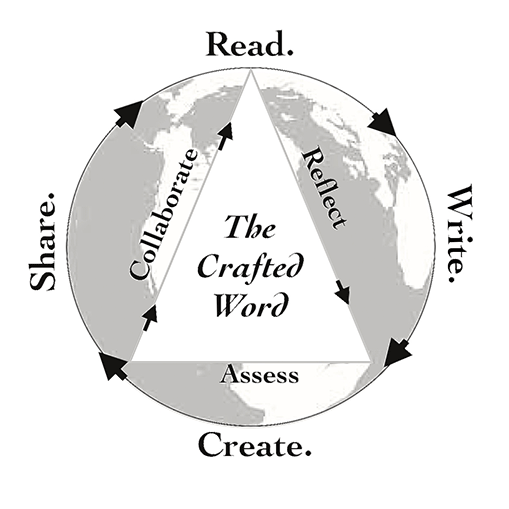


A Shop Teacher’s Thoughts on How To Create True Assessment
Assessment is a terrifying word. I know my students fear it is just a softer term for the harshness of grading–an even more terrifying word, but if we do not assess everything we do, we become the proverbial bearers of repeated mistakes. There are few things that tick my students off more than to get a grade that seems pulled out thin air, riddled with inconsistencies, and is more punitive than enlightening or helpful—but grade we must. It is the Sysyphean chore and duty of every teacher—but does it have to be? Do we teachers have to be final arbiters of fate in this regard? Is there enough room and the grading house to allow the students in? Do our students have to always live like criminals turning themselves over to the authorities for every miscue and misdemeanor in their academic lives—and short of perfection, it seems to be their lot in life. But, if we do not let them in, and if we insist on being their judge and jury, we have squandered the greatest skill they need to master—to be able to to deconstruct their efforts with clear eyes, moral candor, and infinite hope of betterment. In short, let our teaching teach how to assess. Invite students in and let them share and dialogue and assess with us and with each other.
Research shows that we retain little of what we hear in the classroom. The odds increase somewhat (though not dramatically) when we also read what we are supposed to learn; however, learning increases dramatically when we need to present what we learn—and even more dramatically when asked to teach what we have learned. My own students know me as a bit of a pious bear when it comes to learning punctuation; however, as soon as I get on my podium and start talking about punctuation, the room is soon filled with what I call “grammar gas,” which always—as in always—works its way into the very souls of my captives until even the most focused, grade grubbing scholar fades from view and into their own solipsistic reveries—and sometimes simply slip into a hypnotic trance that actually mimics paying attention.
But (the proverbial “but”) when I free them to practice punctuation by watching my videos or laboring through interactive self-grading quizzes and worksheets, they will work endlessly until every single answer is right, and they will then strut around the classroom proud as peacocks to pronounce victory over a dreaded foe. The underlying magic in this approach is that they “see” what they need to do, and while they will never use the word “assess” they are actually living the experience of assessment. They have control of their respective destinies, and they intuitively know where and when they are screwing up and what they have to do to rectify the screw-ups. Putting these newfound skills into future writing pieces is another ballgame, but at least when that red pen circles the comma splice, they are the ones to take the blame, and they can look deeper into themselves for a solution instead of lamenting that I was grading them on something I barely taught!
During exam weeks, I am always amused by teachers who proclaim that no one in their class got higher than a C on his or her exam, as if it were solely the fault of the lazy students who did not prepare for the exam. I bite my tongue and never actually say that they had the whole year to teach what was on the exam. I shudder to think that my back surgeon needed to cram before boring into my spine with a drill! Knowledge needs to be organic. It needs to grow from a well-tended garden fertilized by a continual attention to what makes the fruits and flowers blossom and grow—but instead of a garden, too many students finish the year trying to make sense of a weed-patch of information until they hardly know the weeds from the crops. We move through our curriculums as if driven by a dark force that knows no other way. We teach. We assign. And we grade. And the vicious cycle leaves little room for true and effective mastery. We give what we think is helpful feedback and helpful criticism, but more often than not it is simply degrading commentary that diminishes more than it develops. None of us needs to be assessed more than we—students and teachers alike—as the creators of our works need to assess with skills and techniques that are helpful, hopeful, effective and practical in sustainable ways.
I am better at pontificating than problem solving, and I am loathe to have anyone come into my space and tell me what I should and should not do in my class. I am amazed every day by the sheer dedication I see in my colleagues in preparing their curriculums, grading great sheaves of papers, meeting with lost and wayward students, and easing the minds of over-anxious parents. But we are prey to our own inertia in all endeavors of life, and we need to rethink and retool the grading paradigm and channel our limited energies towards teaching students how to assess and how to move forward after assessing his or her work.
The bear that lurks in the corner of every classroom is the beast of time. No sooner has one task been completed when another rises from the ashes. The lesson planner becomes the tail that wags the dog, and to paraphrase Thoreau: we do not ride the railroad as much as the railroad rides upon us. Our destination is distant and our direction is fixed. The very notion of giving time to students to asses and reflect upon their work is a path fraught with peril and ambiguities, and so even the most well-intentioned and experienced educator is caught in the tangle of duty, obligation and tradition—and ultimately the energy for transformative change remains more dream than reality.
But you can’t jump a canyon in two jumps. We need to make the decision to change the way we grade, and our students need to learn to assess their own work in practical, pedagogically sound and sustainable ways—and we need to make the leap, or at least some of us have to make the jump, if only to show what is possible. All I know is that a good portion of my life is spent reading, marking up, and grading essays. In the crunch times of the year, this amounts to several hours at night when I should be watching NCIS with my kids. It’s crazy, as it seems we grade as if we are the ones being graded—and we are! These marked up essays make their ways into the critical banter in the hallways; they fall into the hands of parents who will dissect and parse our responses more than their children’s work, and we become the fodder of their disdainful gossip. In that sense, my way of grading works. I receive relatively few complaints and more than a share of praise for the efforts I put in, but I no longer think I am doing the right thing. I need to focus on teaching, not assuming a role as sole assessor and arbiter of right from wrong.
In my nostalgia for times gone by, I remember my days as a shop teacher when my most anxious moments at night was to remember to pick up ten 2×4’s at the lumberyard on the way to school—but maybe the approach in the woodshop is a better way. When working in the shop, I never grade their projects; I grade the process of the creation, which certainly levels the playing field. Most importantly, a shop student “knows” what the final product is supposed to look like. They work from drawings, plans, and blueprints; there is a logical and structure and sequence to the workflow, and they can palpably “see” when something is or has gone wrong. These bumps in the road are never a time for criticism—and the student willingly and eagerly seeks the help they need–but more of a time to “figure out” what is going wrong and how to fix it. The do not take the project home to work on the mistakes; they come to the next class ready to work through and overcome the setback. It is a lesson in teaching that can be built into any academic classroom.
The lightbulb for me is to do the heavy work in the classroom where a teacher has oversight of the process and approach—be it writing an essay, completing a lab report, compiling a presentation—or most anything! Homework needs to be what can realistically be completed at home and should be very specific to the needs of the work being done. With seven kids of my own, I have seen firsthand time and time again homework that requires to much processing time and not enough practice time. There is no reason that homework should be a source of massive anxiety, failure, and trepidation—it needs to be doable and calculated to take a certain amount of time, not a list which will take some 10 minutes and others thirty minutes, and it needs to be directly related to the work being done in the classroom. Now, when I assign thirty minutes of reading for homework, I make sure it is thirty minutes by providing audio that is thirty minutes long. If it is an essay or writing piece of some sort, I provide a detailed rubric (blueprint) for them to follow where I only expect a certain type of content not quality of content. If it something I want them to learn and practice by rote, I make sure it is measurable and limited using self-graded flashcard programs and interactive presentations and quizzes. If I grade any one piece of an assignment, it is the writing of a metacognition, which is a brief reflection on a student’s experience of the process. The refining of the content is always down in the shop…I mean, class.
I realize that to many teachers, my epiphany is no great thrust of genius, and it has been their common practice for years. It is a cornerstone of the flipped classroom, but it is certainly not an approach welcomed or practiced by the majority of teachers I know—some who are stubbornly clinging to the tried and true, some who sincerely disagree with me, and some who are too strapped for time to realistically rethink and retool what they do. The downside of my approach is the time and effort it takes to front-load the classwork and homework; the upside is a more empowered, confident and engaged student. Administrators would be wise to spend less time meeting with teachers and more time spent leading workshops and giving teachers the tools and time to develop and sustain this approach.
By doing the down and dirty work in the classroom, assessment becomes a natural and engaged action down with and through each student in an empowering and rarely punitive way. As teachers we need to see how and where a student struggle with our own eyes, mind and heart—and help them when needed, and we need to free them to figure it out when appropriate and, again, doable, which can only be done in the heady and invigorating dynamic of the classroom—the place where we as teachers have control and where out expectations can be carried out with a semblance of clarity and purpose. We cannot and never will be able to control the dynamic of the home environment. Never.
As always, I drone on. Sorry, but I get pumped just thinking of the possibilities of teaching that are more profound and enduring. Changing my ways (stubborn as I am) was a leap across a wide canyon, but the view from the other side is a pretty awesome view.
To assess is to progress.
It is that simple.